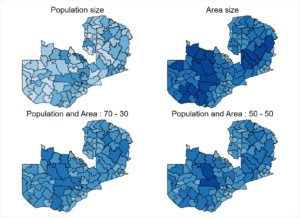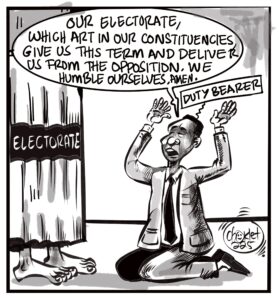The Constituency Development Fund (CDF) has become the signature development and decentralisation programme of the UPND government. Upon forming government, the New Dawn administration increased the fund from a paltry K1.6m, hitherto meant for petty constituency activities such as repair of bridges and other small infrastructure, to K25.7m with an expanded scope. The increase was unprecedented in the history of Zambia and was a manifestation of the government’s resolve to push developments to all corners of the country. In the year 2023, CDF was further increased to K28.3m, the scope of the fund was expanded to cater for activities such as construction of primary school and rural clinics infrastructure, desks, local courts, construction and repair of small bridges, clearance of canals, community boreholes, dip tanks, and small dams as well as empowerment funds for women and youth clubs, including bursary for underprivileged pupils in boarding secondary schools. Some of these activities were all along undertaken by the central government while others are new introduction.
This means going forward, the development trajectories of constituencies were highly influenced by the CDF. Already, there is evidence of construction of classroom blocks, clinics, police posts, all driven by the local community under the auspices of the CDF. The women and youths have also been empowered without having to congest offices in Lusaka. The fund has also complemented the newly introduced free education to secondary schools through bursaries. The administration of such empowerment grants at the constituency level would ensure that the empowerment is not restricted to the line of rail only, where people had easy access to information and government attention. The CDF allows pupils in constituencies from some corners of the country such as Chama, Chavuma, Chiengi, Mapatizya or Sikongo to have equal access to government resources as one in say Lusaka. This is commendable and will go a long way in closing the gap between the poor in remote constituencies and affluent constituencies.
While the expansion of the fund has brought more joy, there are still some equity issues that must be resolved. The first challenge is that CDF is given in equal amounts to unequal constituencies. In this commentary, I want to deal with this and leave other issues for the future. An equal amount of CDF is given to all the constituencies and as the President said when he met HRH Chitimukulu on May 17th, the CDF is disbursed to all constituencies on the same day, as opposed to the practice in the past of disbursing in phases so that some constituencies receive now while others wait. This is despite multifaceted differences in these constituencies in terms of needs based on divergent population sizes or the geographical expanse. For instance, a constituency like Zambezi west with a population less than 29 thousand is given the same amount as Kanyama constituency with almost 20 times the population. If this is shared, each person from baby to the oldest in Zambezi west can get about K1000 from their CDF, while in Kanyama, each only gets about K50. This is also the per head allocation and clearly shows that at an individual level, some get substantially more than others. We can argue that perhaps Kanyama is in Lusaka and may have other privileges that a constituency in Zambezi may not have, the poverty levels may not be the same and therefore the needs. What about twin constituencies of Luanshya districts, Luanshya and Roan constituencies, both in a relatively urban but the former having about twice the population of the latter? Moomba and Bweengwa are both rural constituencies of Monze district, but Moomba has less than half the population of Bweengwa.
In addition, some constituencies may be geographically larger, demanding for more resources in terms of district infrastructure such as roads or schools if we have to ensure the minimum distance of each household from a nearby school or clinic. For instance, Kalumbila district has only one constituency, Kalumbila with a population of more than 177 thousand from the 2022 census, while Mwense district has a population of 122 thousand, much smaller geographically but enjoying two CDFs on account of having two constituencies. There are a lot of differences among the 156 constituencies, population, geography, poverty levels or other needs. Some districts also have the benefit of having more than one constituency so that their local authorities can pool resources while others have to rely on one CDF for the entire district.
The one size fits all that the government employed to allocate the CDF was perfectly understandable in their first year, given they had to present the budget in a period of about two months of forming government. Therefore, there was not going to be enough time to work out these fine details of equitable allocation of resources. Over the years however, there is no justification to continue with a clearly unequitable allocation of resources. The Minister already made a commitment that from 2024, CDF allocation will take into account constituency variations in population and poverty levels. While this is a step towards equity, it is not the destination. In order to contextualise what should be taken into account in the CDF allocation, let us revisit the role of CDF. The empowerment component of CDF must be based on the population size and poverty levels, so that populous or poorer constituencies get more. This will see a constituency like Kanyama get more than Lusaka Central, because the former has almost four times the population and arguably higher poverty levels. More populous constituencies obviously have more women and youth that deserve empowerment and more pupils needing bursary.
The other component of CDF has to do with infrastructure such as primary school buildings and desks, rural clinics and road works. While the population matters, the geographical spread of the population alters the ease with which they can be reached. Geographically smaller but densely populated constituencies are much easier to service than population thinly spread over a large area. In this case, rural constituencies which are large and thinly populated, would need more resources per head.
Programmes such as building local courts, small bridges, clearance of canals or community boreholes have more to do with geographical area than the population itself. Geographically vast constituencies have more infrastructure to attend to. Others such as building dip tanks may depend on economic activities and may be more necessary in certain parts of the country than others.
Clearly, there is more to be considered in order to have a more equitable allocation of CDF. There is need to apportion weights to the different factors that must be taken into account. Weights that ensure that these factors are allocated the correct levels of importance. For instance, some may argue that CDF be based on population alone, giving it 100 percent and anything else zero. Alternatively, we may think of 50% population and 50% poverty level or more finely divided weights. Each of these weights will results in different amounts allocated to different constituencies. Changing the weights or formula results in a change allocations.
The figures show the relative allocation of CDF (by district) based on a formula. The top two represent allocation based entirely on the population or geographical areas, respectively. The bottom are based on a score, giving equal weights to population and area (on the right) or a 70 – 30 split on the left. Basing the allocation on population only would tend to disadvantage districts on the western parts and districts bordering Luapula and Northern provinces. If based on area, the eastern corner of the country and the Copperbelt would be the losers. None of these two extremes is desirable.

The bottom, there is a balance between the two important factors, and a number of districts gain, either from being vast or having bigger populations. These weights are arbitrary and for illustration only, but do reflect the importance of population over area. The maps are also based on a simplistic two-factor scenario. In reality, government must balance a number of factors, but even that, will not satisfy everyone.
Therefore, there is also need for dialogue on these weights so that the formula on CDF allocation is not maliciously misconstrued to be designed to benefit some constituencies more than others. In any case, there need for further research and evidence generation cannot be over emphasised. The allocation must be informed by available evidence. This calls for the involvement of research units or think tanks to design an appropriate formula. But not all can be achieved in one year. What is important is maintaining the process of improvement and keeping the lines of dialogue open.
Going forward, we must perhaps begin to think of decentralising many other government programmes in order to ensure resources and opportunities are spread across the country. One such is the higher education loans, given to deserving students in higher institutions of learning or simply universities. The loans continue to be administered from the centres, and potentially attracting applicants that have easy access to offices and information. But how can we verify this? With so much migration and integration, the district on the NRC no longer shows where one comes from, but where forefathers came from. A true picture of where people are coming from can be proxied by the school where one did their primary schooling. A profiling of recipients may actually show that there is under representation of remote areas as recipients are drawn from privileged societies. The spread of higher education bursaries across the country can be checked by interrogating where each recipient did their primary schooling. Do we have all the primary schools represented or what is the distribution of primary schools among recipients. This will show if the opportunity has been given to all or has been captured along the line of development. As the President would put it, there is need to ensure these opportunities are given to all, and that no societies must be confined to cattle herding, charcoal burning or fishing as only viable potential careers for our pupils.
The author is a lecturer of Economics at the University of Zambia and a research fellow at the University of Cape Town. For feedback, email: obriandhlovu@yahoo.com
























